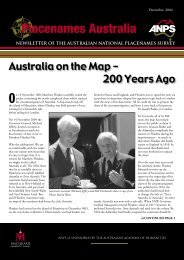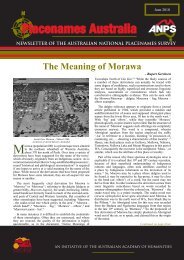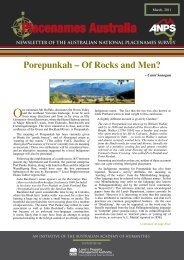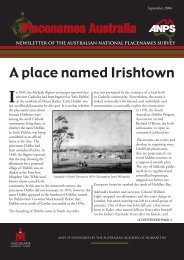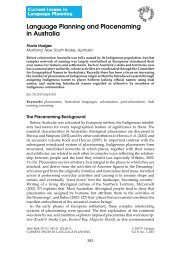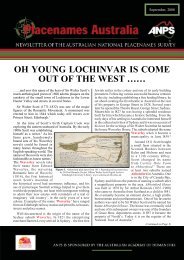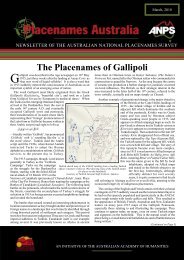Create successful ePaper yourself
Turn your PDF publications into a flip-book with our unique Google optimized e-Paper software.
Thus, Flinders placed the old Maatsuijker River as the large,open sea between Sweers Island and the mainland, and hisnew Sweers Island as the small headland west of that ‘river’ onthe Thévenot map.Flinders’s reason for naming this island after VOC councillorSweers is rather complex. Most of the South Wellesley Islandshe named after Englishmen -- Bentinck after the Governorof Madras, William Bentinck; Allen Islands after a memberof his crew, etc. -- but the island on which he established ashore camp he reserved for the Dutch, as a tribute to thosewho had travelled there before him. His first thought wasto transfer the name Maatsuijker (or Maatsuyker, in Englishtranscription) from the river to the island, but since aMaatsuyker Group already existed in Van Diemens Land(Tasmania), explains Flinders, he chose Sweers instead. Weare not sure whether Flinders knew about the existence ofan old Sweers River in the area, but he certainly knew allthe old VOC councillors well from the literature he hadaccess to. There is no Sweers River on the Thévenot map’snomenclature.The Bonaparte Tasman mapThe Bonaparte Tasman map has its name from its one-timeowner Prince Roland Bonaparte, grandson of Napoleon’sbrother Lucien. Prince Roland purchased it from FrederickMüller in Holland in 1891, and the Prince’s daughter Marie,married to Prince George of Greece, gave it to the MitchellWing of the State Library of New South Wales in 1933.While there exist three complete journals of the 1642-43expedition, including the Mitchell Library’s copy and theso-called ‘Sailor’s Journal’, both once in Salomon Sweers’sownership, no journals of the 1644 expedition are known.This is why various 17th-century maps are the major sources ofinformation for this second voyage, and the Bonaparte Tasmanmap in particular. The route is laid down in great detail withsoundings and anchorages where they stopped for the night.Several other 17th-century maps include Tasman’s discoveries,but none in such detail.the map. Even more importantly, Anderson argues that hecan recognize the distinct handwriting of Isaac Gilsemanson the map. Gilsemans sailed with Tasman as supercargo,and without going into detail here, this piece of informationwould place the Bonaparte Tasman map as drawn in Batavia,in surroundings where it would seem very natural that itcould be made, no later than 1646 when Gilsemans died. Henever returned to the Netherlands.Tasman’s course around South WellesleyMany authors have tried to put Sweers and MaatsuijkerRivers on the modern map. They all tend to look to thevarious rivers and creeks that flow into the sea in the southeastern,inner part of the Gulf. Flinders, we recall, thoughtMaatsuijker was the open sea south of the South WellesleyGroup.We see it differently. Sweers Islands Unveiled has anexplanation of several pages that leads up to the conclusionbriefly presented here. We have looked at soundings andlandscape features on the Bonaparte Tasman map, we havestudied how Flinders approached the area in 1802, and wehave used local knowledge to try out all likely and unlikelypossibilities to pass the South Wellesley Group withoutcharting them as islands. Basically, our method was to putourselves mentally onboard Tasman’s ship, forgetting all weknew about modern maps in our attempt to see his worldthrough his eyes – and only later compare what we foundwith the real world.Figure 2: The outline of the Bonaparte Tasman map in the southeasternarea of the Gulf of Carpentaria, with old names and ourtheories on where to apply modern names. (Illustration by C.B.Høgenhoff, <strong>2006</strong>)The age of the map has been a matter of controversy. Whileit was believed in 1933 that it was an original map fromTasman’s time, a study performed in 1941 concluded that itis a copy, probably made around 1695 by an unknown Dutchcartographer. This conclusion has been commonly acceptedover the last 60 years, but is now in question.In this article and also in Sweers Islands Unveiled, I underlinethat the analysis we make deals only with some very fewoutlines in the Gulf of Carpentaria. The debate regardingthe age of the Bonaparte Tasman map goes into angles anddetails far beyond what is discussed here. However, a recentstudy by Grahame Anderson 4 concludes that the map wasnot drawn by one hand as indicated in the 1940s analysis,but that at least four people were involved in the making of



